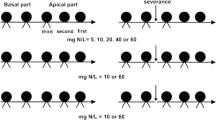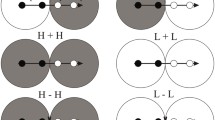Abstract
Physiological integration between connected ramets can increase the performance of clonal plants when ramets experience contrasting levels of resource availabilities in heterogeneous environments. It has generally been shown or assumed that clonal integration has little effect on clonal performance in homogeneous environments. However, a conceptual model suggests that integration could increase performance in a homogeneous environment when connected ramets differ in uptake ability and external resource supply is high. We tested this hypothesis in a greenhouse experiment with the amphibious plant Alternanthera philoxeroides. Ramets in clonal fragments containing three rooted and two unrooted ramets were either left connected or divided into a basal part with two rooted ramets and an apical part with the other ramets. To simulate realistic, homogeneous environments of the species with different levels of resource supply, plants were grown at 0, 20, or 40 cm of water depth. Water depth had a positive effect on most measures of growth, indicating that resource supply increased with depth. Connection had negative to neutral effects on total growth of fragments at a water depth of 0 cm, and neutral to positive effects at 20- and 40-cm depths; effects on the apical part were generally positive and larger at greater depth; effects on the basal part were generally negative and smaller at greater depth. Results largely supported the hypothesis and further suggest that clonal integration of allocation and reproduction may modify benefits of resource sharing in homogeneous environments.





Similar content being viewed by others
References
Alpert P (1991) Nitrogen-sharing among ramets increases clonal growth in Fragaria chiloensis. Ecology 72:69–80
Alpert P (1996) Nutrient sharing in natural clonal fragments of Fragaria chiloensis. J Ecol 84:395–406
Alpert P (1999) Clonal integration in Fragaria chiloensis differs between populations: ramets from grassland are selfish. Oecologia 120:69–76
Alpert P, Mooney HA (1986) Resource sharing among ramets in the clonal herb, Fragaria chiloensis. Oecologia 70:227–233
Balestri E, Lardicci C (2013) The impact of physical disturbance and increased sand burial on clonal growth and spatial colonization of Sporobolus virginicus in a coastal dune system. PLoS ONE 8:e72598
Caldwell MM, Pearce RP (2012) Exploitation of environmental heterogeneity by plants: ecophysiological processes above- and belowground. Academic Press, San Diego
Chen XS, Deng ZM, Xie YH, Li F, Hou ZY, Li X, Li YF (2014) Effects of sediment burial disturbance on the vegetative propagation of Phalaris arundinacea with different shoot statuses. Aquat Ecol 48:409–416
da Cunha NL, Fischer E, Lorenz-Lemke AP, Barrett SCH (2014) Floral variation and environmental heterogeneity in a tristylous clonal aquatic of the Pantanal wetlands of Brazil. Ann Bot 114:1637–1649
de Kroon H, van Groenendael J (1997) The ecology and evolution of clonal growth in plants. Backhuys Publishers, Leiden
Dong BC, Alpert P, Guo W, Yu FH (2012) Effects of fragmentation on the survival and growth of the invasive, clonal plant Alternanthera philoxeroides. Biol Invasions 14:1101–1110
Dutilleul PRL (2011) Spatio-temporal heterogeneity: concepts and analyses. Cambridge University Press, New York
Engelhardt KAM, Lloyd MW, Neel MC (2014) Effects of genetic diversity on conservation and restoration potential at individual, population, and regional scales. Biol Conserv 179:6–16
Evans JP, Whitney S (1992) Clonal integration across a salt gradient by a nonhalophyte, Hydrocotyle bonariensis (Apiaceae). Am J Bot 79:1344–1347
Gao L, Li B, Liu WY, Shen YX, Liu WJ (2013) Inhibition effects of daughter ramets on parent of clonal plant Eichhornia crassipes. Aquat Bot 107:47–53
Gao Y, Wang D, Xing F, Liu J, Wang L (2014) Combined effects of resource heterogeneity and simulated herbivory on plasticity of clonal integration in a rhizomatous perennial herb. Plant Biol 16:774–782
Geng YP, Pan XY, Xu CY, Zhang WJ, Li B, Chen JK, Lu BR, Song ZP (2007) Phenotypic plasticity rather than locally adapted ecotypes allows the invasive alligator weed to colonize a wide range of habitats. Biol Invasions 9:245–256
Hara A, Hamasaki K, Yoshida K, Yusa Y (2015) Canal type affects invasiveness of the apple snail Pomacea canaliculata through its effects on animal species richness and waterweed invasion. Biol Invasions 17:63–71
He WM, Alpert P, Yu FH, Zhang LL, Dong M (2011) Reciprocal and coincident patchiness of multiple resources differentially affect benefits of clonal integration in two perennial plants. J Ecol 99:1202–1210
Holm LG, Doll J, Holm E, Pancho J, Herberger J (1997) World weeds: natural histories and distribution. Wiley, New York
Hutchings MJ, Wijesinghe DK (1997) Patchy habitats, division of labour and growth dividends in clonal plants. Trends Ecol Evol 12:390–394
Jackson GD (2000) Effects of nitrogen and sulfur on canola yield and nutrient uptake. Agron J 92:644–649
Julien MH, Skarratt B, Maywald GF (1995) Potential geographical distribution of alligator weed and its biological control by Agasicles hygrophila. J Aquat Plant Manag 33:55–60
Lambers H, Chapin FS, Pons TL (2008) Plant physiological ecology, 2nd edn. Springer-Verlag New York Inc, New York
Li J, Ye WH (2006) Genetic diversity of alligator weed ecotypes is not the reason for their different responses to biological control. Aquat Bot 86:155–158
Liu C, Yu D (2009) The bud and root sprouting capacity of Alternanthera philoxeroides after over-wintering on sediments of a drained canal. Photosynthetica 623:251–256
Lobo FA, de Barros MP, Dalmagro HJ, Dalmolin AC, Pereira WE, de Souza E, Vourlitis G, Ortiz CR (2013) Fitting net photosynthetic light-response curves with Microsoft Excel—a critical look at the models. Photosynthetica 51:445–456
Luo FL, Chen Y, Huang L, Wang A, Zhang MX, Yu FH (2014) Shifting effects of physiological integration on performance of a clonal plant during submergence and de-submergence. Ann Bot 113:1265–1274
Ma RY, Wang R (2005) Invasive mechanism and biological control of alligator weed, Alternanthera philoxeroides (Amaranthaceae), in China. Chin J Appl Environ Biol 11:246–250
Maxwell SE, Delaney HD (2004) Designing experiments and analyzing data: a model comparison perspective, 2nd edn. Psychology Press, New York
Pan XY, Geng YP, Sosa A, Zhang WJ, Li B, Chen JK (2007) Invasive Alternanthera philoxeroides: biology, ecology and management. Acta Phytotaxon Sin 45:884–900
Poor A, Hershock C, Rosella K, Goldberg DE (2005) Do physiological integration and soil heterogeneity influence the clonal growth and foraging of Schoenoplectus pungens? Plant Ecol 181:45–56
Roiloa SR, Hutchings MJ (2013) The effects of physiological integration on biomass partitioning in plant modules: an experimental study with the stoloniferous herb Glechoma hederacea. Plant Ecol 214:521–530
Roiloa SR, Rodriguez-Echeverria S, Freitas H, Retuerto R (2013) Developmentally-programmed division of labour in the clonal invader Carpobrotus edulis. Biol Invasions 15:1895–1905
Rutherford A (2012) ANOVA and ANCOVA: a GLM approach, 2nd edn. Wiley, Singapore
Schooler SS, Cook T, Prichard G, Yeates AG (2010) Disturbance-mediated competition: the interacting roles of inundation regime and mechanical and herbicidal control in determining native and invasive plant abundance. Biol Invasions 12:3289–3298
Si CC, Dai ZC, Lin Y, Qi SS, Huang P, Miao SL, Du DL (2014) Local adaptation and phenotypic plasticity both occurred in Wedelia trilobata invasion across a tropical island. Biol Invasions 16:2323–2337
Song YB, Yu FH, Keser LH, Dawson W, Fischer M, Dong M, van Kleunen M (2013) United we stand, divided we fall: a meta-analysis of experiments on clonal integration and its relationship to invasiveness. Oecologia 171:317–327
Touchette BW, Moody JWG, Byrne CM, Marcus SE (2013) Water integration in the clonal emergent hydrophyte, Justicia americana: benefits of acropetal water transfer from mother to daughter ramets. Hydrobiologia 702:83–94
Vermeulen PJ, Stuefer JF, Anten NPR, During HJ (2009) Carbon gain in the competition for light between genotypes of the clonal herb Potentilla reptans. J Ecol 97:508–517
Vervuren PJA, Blom CWPM, de Kroon H (2003) Extreme flooding events on the Rhine and the survival and distribution of riparian plant species. J Ecol 91:135–141
Vretare Strand V, Weisner SEB (2002) Interactive effects of pressurized ventilation, water depth and substrate conditions on Phragmites australis. Oecologia 131:490–497
Wang N, Yu FH, Li PX, He WM, Liu FH, Liu JM, Dong M (2008) Clonal integration affects growth, photosynthetic efficiency and biomass allocation, but not the competitive ability, of the alien invasive Alternanthera philoxeroides under severe stress. Ann Bot 101:671–678
Wang N, Yu FH, Li PX, He WM, Liu J, Yu GL, Song YB, Dong M (2009) Clonal integration supports the expansion from terrestrial to aquatic environments of the amphibious stoloniferous herb Alternanthera philoxeroides. Plant Biol 11:483–489
Wolfer SR, Straile D (2012) To share or not to share: clonal integration in a submerged macrophyte in response to light stress. Hydrobiologia 684:261–269
Xu CY, Schooler SS, van Klinken RD (2010) Effects of clonal integration and light availability on the growth and physiology of two invasive herbs. J Ecol 98:833–844
Ye WH, Li J, Cao HL, Ge HJ (2003) Genetic uniformity of Alternanthera philoxeroides in south China. Weed Res 43:297–302
You WH, Yu D, Xie D, Yu LF, Xiong W, Han CM (2014) Responses of the invasive aquatic plant water hyacinth to altered nutrient levels under experimental warming in China. Aquat Bot 119:51–56
Yu FH, Chen YF, Dong M (2002) Clonal integration enhances survival and performance of Potentilla anserina, suffering from partial sand burial on Ordos plateau, China. Evol Ecol 15:303–318
Yu FH, Wang N, Alpert P, He WM, Dong M (2009) Physiological integration in an introduced, invasive plant increases its spread into experimental communities and modifies their structure. Am J Bot 96:1983–1989
Zhang YC, Zhang QY, Sammul M (2012) Physiological integration ameliorates negative effects of drought stress in the clonal herb Fragaria orientalis. PLoS ONE 7:e44221
Acknowledgments
We thank Rui-Hua Liu, Yong-Yang Wang, and Li–Li Zheng for research assistance. Research was supported by the Fundamental Research Funds for the Central Universities (TD-JC-2013-1), the National Natural Science Foundation of China (No. 31200313 and No. 31200314). This paper was based in part on work supported by the US National Science Foundation because Peter Alpert co-authored the study while working at the Foundation, but the paper does not necessarily reflect the views of the Foundation.
Author information
Authors and Affiliations
Corresponding author
Additional information
Communicated by Stephan Hattenschwiler.
Rights and permissions
About this article
Cite this article
Dong, BC., Alpert, P., Zhang, Q. et al. Clonal integration in homogeneous environments increases performance of Alternanthera philoxeroides . Oecologia 179, 393–403 (2015). https://doi.org/10.1007/s00442-015-3338-y
Received:
Accepted:
Published:
Issue Date:
DOI: https://doi.org/10.1007/s00442-015-3338-y




